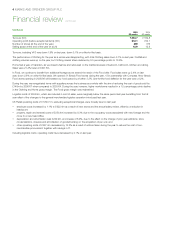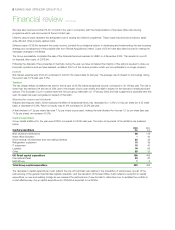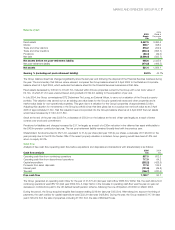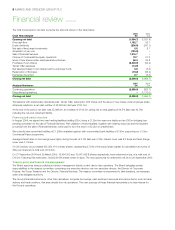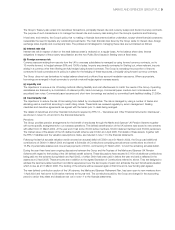Marks and Spencer 2005 Annual Report Download - page 16
Download and view the complete annual report
Please find page 16 of the 2005 Marks and Spencer annual report below. You can navigate through the pages in the report by either clicking on the pages listed below, or by using the keyword search tool below to find specific information within the annual report.
14 MARKS AND SPENCER GROUP PLC
Corporate governance continued
Accountability and audit
The Group’s overriding corporate objective is to maximise long-
term shareholder value whilst exceeding the expectations of our
customers, employees and partners. In doing so, the directors
recognise that creating value is the reward for taking and
accepting risk.
The Board has overall responsibility for the Group’s approach to
assessing risk and systems of internal control, and for monitoring
their effectiveness in providing shareholders with a return that is
consistent with a responsible assessment and mitigation of risks.
This includes reviewing financial, operational and compliance
controls and risk management procedures. The role of executive
management is to implement the Board’s policies on risk and
control, and present assurance on compliance with these policies.
Independent assurance is presented by internal audit, which
operates across the Group, and the external auditors. All
employees are accountable for operating within these policies.
Because of the limitations that are inherent in any system of
internal control, this system is designed to manage, rather than
eliminate, the risk of failure to achieve corporate objectives.
Accordingly, it can only provide reasonable but not absolute
assurance against material misstatement or loss.
Risk assessment
Every six months the Board reviews the Group Risk Profile – the
tool that drives risk assessment and action planning. This is
supported by an ongoing process for identifying, evaluating and
managing the significant risks faced by the Group. As an integral
part of planning and review, managers from each business area
and major projects identify the risks to their plans, the probability of
those risks occurring, the impact if they do occur and the actions
being taken to manage those risks to the agreed boundaries for
risk taking. This information is communicated upwards on a filter
basis, culminating in a comparison with the executive directors’
assessment of the Group’s risks and discussion by the Board.
This process has been in place for the year under review and up
to the date of approval of the annual report and accounts. It has
been regularly reviewed by the Board and accords with the Internal
Control Guidance for directors on the Code produced by the
Turnbull working party.
Internal control
The Board maintains full control and direction over appropriate
strategic, financial, organisational and compliance issues. It has
delegated to executive management the implementation of the
systems of internal control within an established framework.
The Board has put in place an organisational structure with
formally defined lines of responsibility and delegation of authority.
There are also established procedures for planning, capital
expenditure, information and reporting systems, and for monitoring
the Group’s businesses and their performance. These include:
Plans and policies
•communication of the Group’s strategy, objectives and targets;
•annual operating and capital plans and future projections;
•operating policies and procedures;
•clearly defined capital investment control guidelines;
•review of treasury policies by the treasury committee; and
•review of social, environmental and ethical matters by the
corporate social responsibility committee.
Competent people
•appointment of employees of the necessary calibre to fulfil their
allotted responsibilities; and
•clear roles and accountabilities with regular performance
reviews.
Monitor and control
•review by operating divisions of their plans with the relevant
executive directors prior to submission to the Board for
approval, including identification and assessment of risks;
•monthly comparison of operating divisions’ actual financial
performance against budget; and
•regular consideration by the Board of year-end forecasts.
Regulatory update
•reporting of accounting and legal developments; and
•regular briefings on latest best practice corporate governance
to the Board.
Assurance
On behalf of the Board, the audit committee examines the
effectiveness of the Group’s:
•assessment of risk by reviewing evidence of risk assessment
activity and a report from internal audit on the process
undertaken; and
•systems of internal control, primarily through approving the
internal audit plan and reviewing its findings, reviews of the
annual and interim financial statements and a review of the
nature, scope and reports of the external audit.
Any significant findings or identified risks are closely examined so
that appropriate action can be taken. Management is called upon
to present action plans and give representation. The audit
committee has completed its review of the effectiveness of the
Group’s systems of internal control during the year.
Internal audit’s work is focused on areas of priority as identified by
the Group Risk Profile and in accordance with an annual audit plan
approved each year by the audit committee and by the Board. The
Board receives a full report from the Chief Internal Auditor each
year on the department’s work and findings and regular interim
updates on specific issues.
The external auditors are engaged to express an opinion on the
financial statements. They review and test the systems of internal
financial control and the data contained in the financial statements
to the extent necessary to express their audit opinion. They
discuss with management the reporting of operational results and
the financial position of the Group and present their findings to the
audit committee.
Relations with shareholders
We are committed to ongoing engagement with shareholders and
have a well established cycle of communication based on the
Group’s financial reporting calendar. At times of rapid change it is
even more important to keep all investors properly informed. We
promote the use of electronic communication and relaunched our
corporate website in May 2005. All Company announcements and
presentations are made available simultaneously on our website,
which also contains corporate and customer information updated
on a regular basis. There is a corporate governance section which
includes our full response to the Code and terms of reference for
the principal Board committees. Our registrars have also
developed www.shareview.co.uk – an electronic service where


